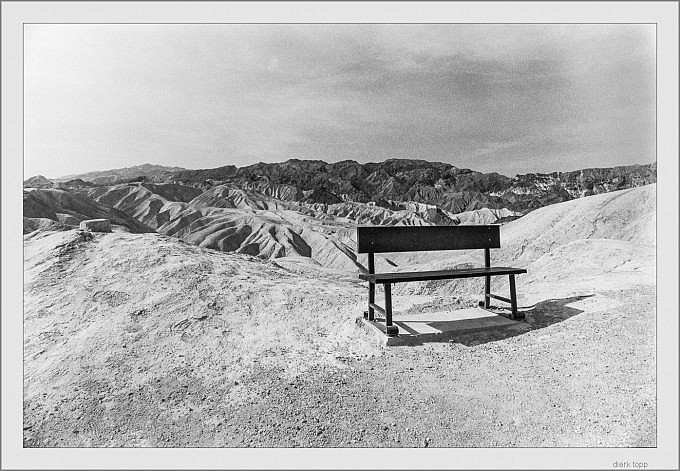Film Friday: Death Valley 1987
by Dierk Topp
In 1987 I spent 3 months on an assignment in San Francisco, CA. At that time the Kodak T-MAX was announced and Kodak said: The world’s finest grained 100-speed black-and-white film.
To be sure I took many roles of film with me. On a weekend trip I took many shots in the Death Valley with my Nikon FA and good prime Nikkor lenses, polarizer, tripod and mirror lock up to make sure, to get the best possible results.
Of course I had no lab with me and gave the film to a professional lab for development.
But:
When I got the developed film back, I was very disappointed. I could see the grain and dirt with the naked eye! It looked more like ISO 800 or even higher to me.
What I was told and did not know: Kodak tested new products abroad to avoid any problems in the USA. When I asked the lab, they told me, they did not know the film and developed the film in their “normal soup” !!
Find the result below. It is about the best, I could get.
More of this series in my flickr album “Death Valley 1987, T-Max 100, Nikon SLR”
I digitized the negatives with a Sony A7R, bellows with enlarger lens and flash. Processing with Lightroom 5.
Dierk Topp

Who goes on a major trip with film they have not tested?
With all of these people using great digital cameras in combination with old style bellows to “scan” their negs/slides, the usually bargain priced “bellows” are now escalating in value (darn!)
Also, I hate when you work so hard to set up your shots, plus spend the time & expense, only to have a lab mistake virtually ruin all of it ! (Typically my dev dilution mistake)
Finally, just so folks aren’t searching for the button, lever or knob in order to lock-up the mirror on a Nikon FA, STOP LOOKING; it’s the use of the self-timer that mimics a MLU…
bingo, Gus 🙂
I was wondering, if somebody will even notice the remark about the MLU! I happened to find the trick, when I noticed, that the camera starts the self timer after the mirror.
For Leica M9 and MM users:
there is a hidden T function. Set the shutter on B and use the self timer and the camera behaves like the good old T setting: the shutter stays open till you hit the shutter release the second time.
Great Images, You should be selling some of these as wall art
thanks, Mark
I feel honored,
but I think, these images are technically not good enough for selling prints.
I have to try higher resolution by shooting the negative in 4 parts and stitch (as I did with 6×6), but you don’t get more, that what is in the film.
thanks very much for all your friendly comments, very much appreciated!
Jerome, as said in the beginning, it was a Nikon FA and i used a 21mm and a 35mm shift lens.
I planed to take lots of Agfa APX 25 film with me. Than I read about the new T-MAX100 and took the T-MAX 🙁
The grain has a certain charm and no problems with the sand, but if the sky looks like sand too, I am disappointed.
With my gear and possibilities from today I would shoot hi resolution stitched images of 200 MPixel and can print it 2m wide. But I will not have a chance to go there again.
regards
dierk
Grains of film and sand, like happy accidents, go hand in hand. The fourth from the bottom is so surreal. Well done, sir.
grain or no grain, still outstanding….
was it a holga? 🙂
I don’t see the problem…love the grain!
I can well understand your frustration. Stunning compositions. Thank you for sharing.
Beautiful. Black and white landscapes done well are truly inspirational.
These are great, and the grain doesn’t matter. It adds some charm.
Love Bad Water and Zabriskie Point! Wonderful photographs.
I Love your Photos!!!
They are nice nonetheless. One of the little joys of film, I guess.
I understand your frustration – but I think the photos and grain are pretty wonderful.